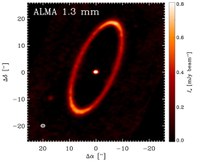Mapping a Complete Debris Disk
MacGregor et al. present ALMA mosaic observations at 1.3 mm (223 GHz) of the Fomalhaut system. These observations provide the first millimeter map of the continuum dust emission from the complete outer debris disk with uniform sensitivity, enabling the first conclusive detection of apocenter glow. The authors adopt a modeling approach that accounts for the eccentric orbital parameters of a collection of particles within the disk. The outer belt is radially confined with an inner edge of 136.3 ± 0.9 Astronomical Units (AU) and width of 13.5 ± 1.8 AU, with a best-fit eccentricity of 0.12 ± 0.01.
Assuming a size distribution power-law index of q = 3.46 ± 0.09, the dust absorptivity power-law index β is constrained to be 0.9 < β < 1.5. The geometry of the disk is robustly constrained with inclination 65.6° ± 0.3°, position angle 337.9° ± 0.3°, and argument of periastron 22.5° ± 4.3°. These ALMA observations do not confirm any of the azimuthal features found in previous imaging studies of the disk with HST, the Submillimeter Common-User Bolometer Array, and ALMA. However, they cannot rule out structures ≤10 AU in size or that only affect smaller grains. The central star is clearly detected with a flux density of 0.75 ± 0.02 mJy, significantly lower than predicted by current photospheric models.
Image: ALMA image of the 1.3 mm continuum emission from Fomalhaut. The dashed white ellipse in the lower left corner shows the natural weight beam size of 1.56 x 1.15 arcsec.
Publications: Meredith A. MacGregor (Harvard-Smithsonian Center for Astrophysics) et al., A Complete Map of the Fomalhaut Debris Disk, 2017, Astrophysical Journal, 842, 8.





Connect with NRAO